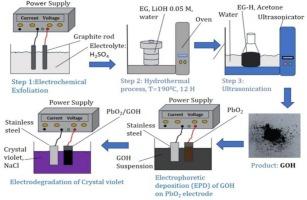High-performance electrocatalytic degradation of crystal violet using graphene hydroxide-modified PbO2 electrode
IF 4.2
Q2 CHEMISTRY, MULTIDISCIPLINARY
引用次数: 0
Abstract
Electrocatalytic degradation of crystal violet using PbO₂/GOH electrodes (GOH: graphene hydroxide) has been carried out. GOH was synthesized via exfoliation, hydrothermal, and ultrasonication, while the PbO₂/GOH electrode was prepared using EPD (electrophoretic deposition). GOH exhibits a single peak at 266 nm, high intensity of C![]() C and O
C and O![]() H stretching vibrations, and an ID/IG ratio of 0.55 in the Raman spectrum. The XRD pattern shows peak broadening and a 98.22 % decrease in intensity, while the SEM image shows aggregated graphene sheets, a slightly rough surface, and porosity in the form of gaps. The TEM image shows thin GOH layers, and SEM-EDX data indicate that GOH has a C/O ratio of 2.04. The interaction between PbO₂ and GOH is marked by new bands at 683, 843, and 1409 cm−1. The morphological change of PbO₂ from fine to coarse particles in PbO₂/GOH was observed via SEM-EDX, indicating interaction between PbO₂ and GOH. Based on SEM-EDX results, the C/O/Pb ratio in PbO₂/GOH is 79.36/17.72/1.46 %. The cyclic voltamogram of PbO₂/GOH shows that the current increases by 73.33 % and the voltage decreases by 23.53 %. The electrodegradation of the crystal violet using PbO₂/GOH within 10 min can remove 99 % of the dye, reduce BOD by 94.08 %, and COD by 95.79 %, while in actual wastewater, it can remove 96 % of the dye and reduce BOD and COD by 97 % and 98 %, respectively. The electrode can be reused up to 10 cycles, and the dissolution of Pb2+ ions decreased by 71.66 % compared to unmodified PbO₂ electrodes.
H stretching vibrations, and an ID/IG ratio of 0.55 in the Raman spectrum. The XRD pattern shows peak broadening and a 98.22 % decrease in intensity, while the SEM image shows aggregated graphene sheets, a slightly rough surface, and porosity in the form of gaps. The TEM image shows thin GOH layers, and SEM-EDX data indicate that GOH has a C/O ratio of 2.04. The interaction between PbO₂ and GOH is marked by new bands at 683, 843, and 1409 cm−1. The morphological change of PbO₂ from fine to coarse particles in PbO₂/GOH was observed via SEM-EDX, indicating interaction between PbO₂ and GOH. Based on SEM-EDX results, the C/O/Pb ratio in PbO₂/GOH is 79.36/17.72/1.46 %. The cyclic voltamogram of PbO₂/GOH shows that the current increases by 73.33 % and the voltage decreases by 23.53 %. The electrodegradation of the crystal violet using PbO₂/GOH within 10 min can remove 99 % of the dye, reduce BOD by 94.08 %, and COD by 95.79 %, while in actual wastewater, it can remove 96 % of the dye and reduce BOD and COD by 97 % and 98 %, respectively. The electrode can be reused up to 10 cycles, and the dissolution of Pb2+ ions decreased by 71.66 % compared to unmodified PbO₂ electrodes.

氢氧化石墨烯修饰PbO2电极高效电催化降解结晶紫
采用PbO 2 /GOH电极(GOH:氢氧化石墨烯)对结晶紫进行了电催化降解。采用剥离法、水热法和超声波法合成GOH,电泳沉积法制备PbO₂/GOH电极。GOH在266 nm处呈现单峰,具有高强度的CC和OH拉伸振动,拉曼光谱的ID/IG比为0.55。XRD图显示石墨烯峰展宽,强度下降98.22%,SEM图显示石墨烯片聚集,表面略粗糙,孔隙以间隙形式存在。TEM图像显示出较薄的GOH层,SEM-EDX数据显示GOH的C/O比为2.04。PbO₂与GOH的相互作用在683、843和1409 cm−1处出现了新的条带。SEM-EDX观察了PbO₂/GOH中PbO₂由细颗粒到粗颗粒的形态变化,表明PbO₂与GOH之间存在相互作用。SEM-EDX结果显示,PbO₂/GOH中C/O/Pb比值为79.36/17.72/ 1.46%。PbO₂/GOH的循环伏安图表明,电流增加73.33%,电压降低23.53%。PbO 2 /GOH在10 min内电降解结晶紫,染料去除率为99%,BOD降低94.08%,COD降低95.79%,而在实际废水中,染料去除率为96%,BOD和COD分别降低97%和98%。该电极可重复使用10次,与未修饰的PbO 2电极相比,Pb2+离子的溶解减少了71.66%。
本文章由计算机程序翻译,如有差异,请以英文原文为准。
求助全文
约1分钟内获得全文
求助全文

 求助内容:
求助内容: 应助结果提醒方式:
应助结果提醒方式:


